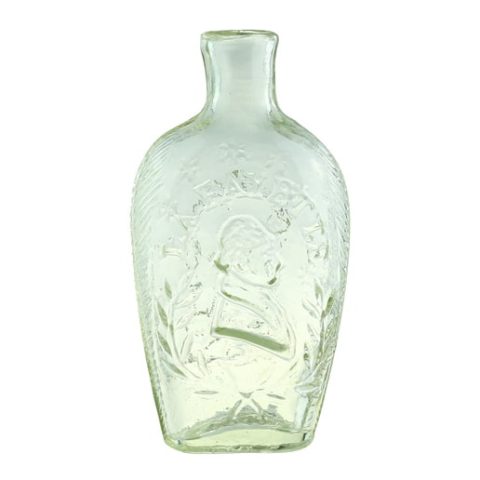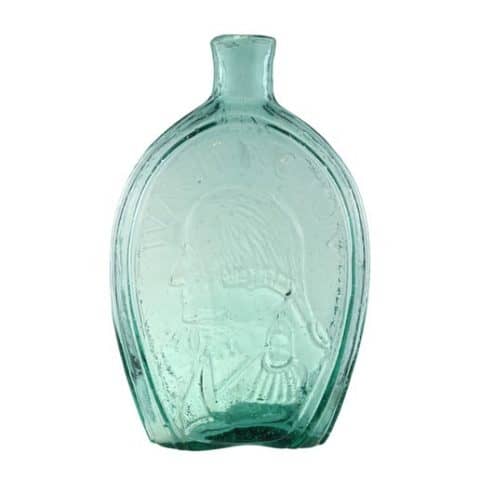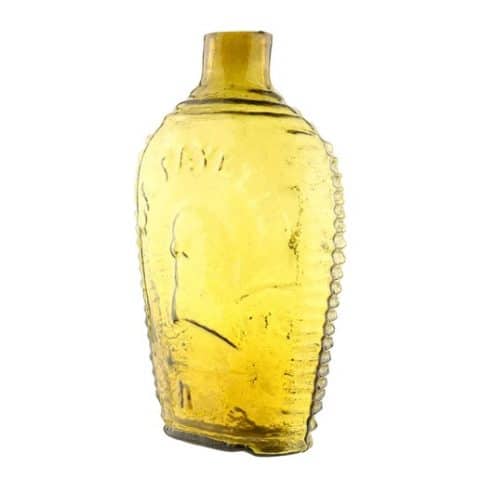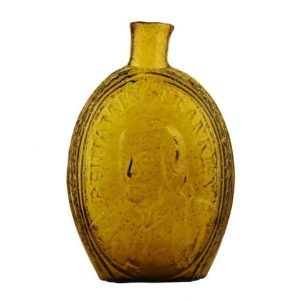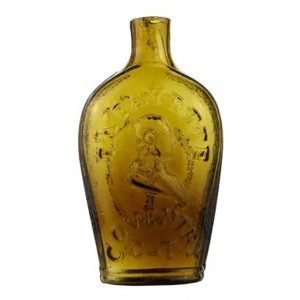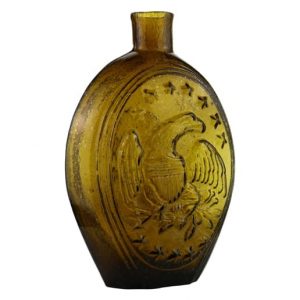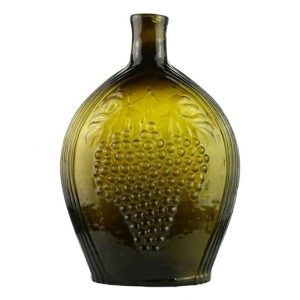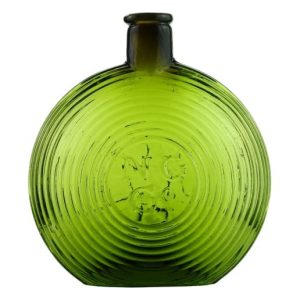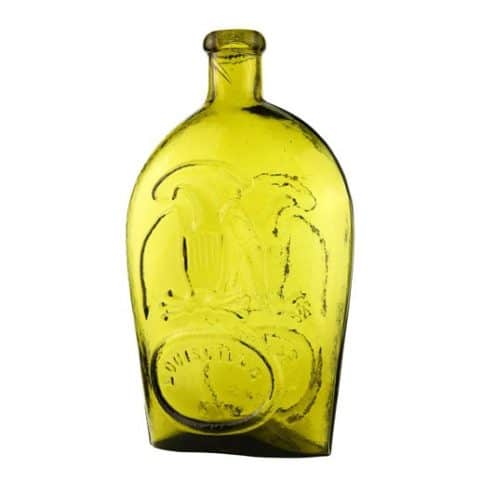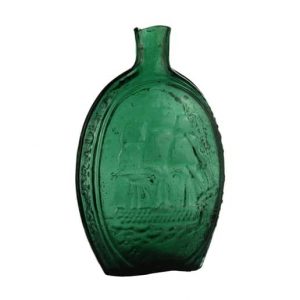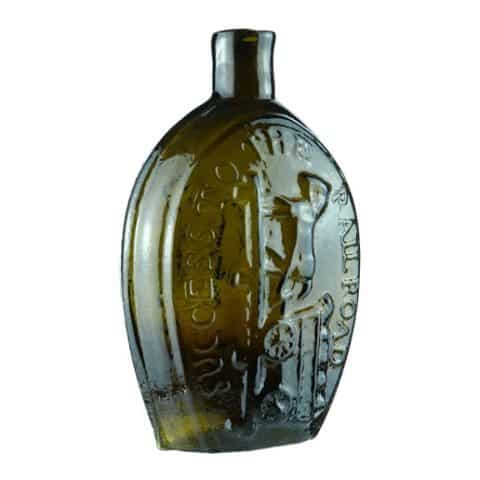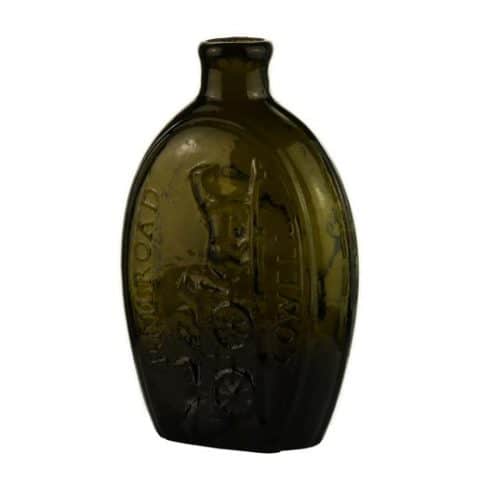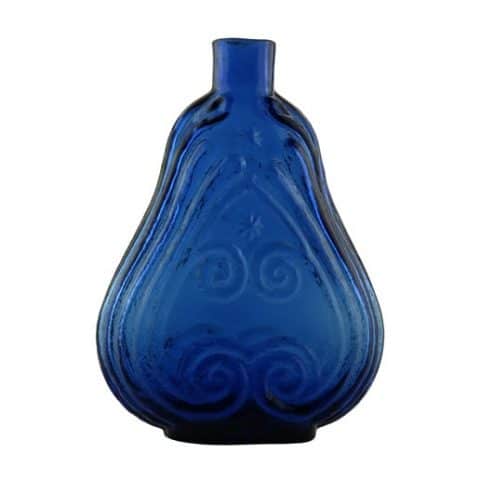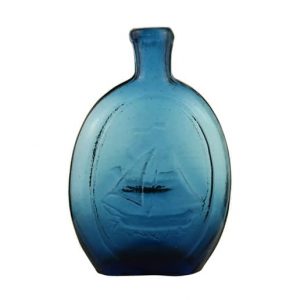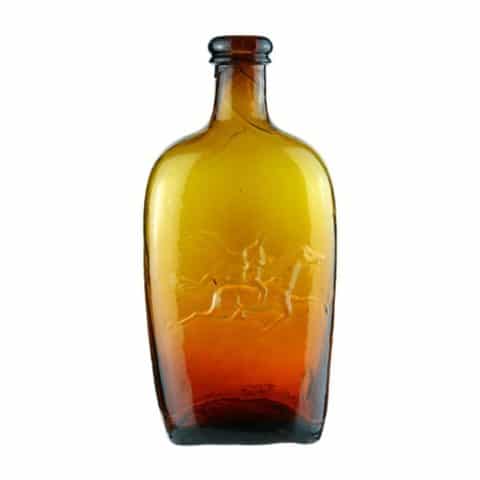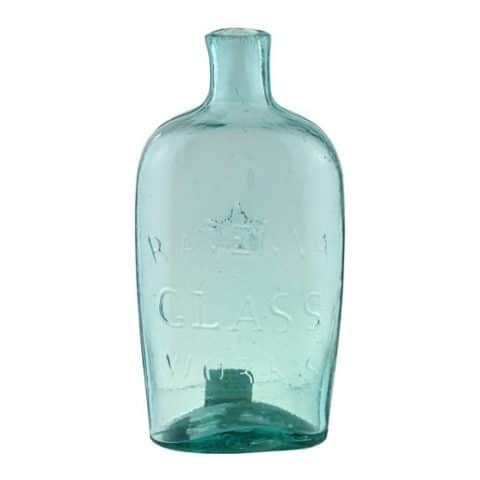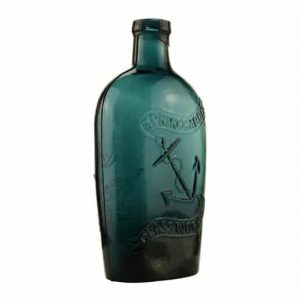GXIII-17 • Horseman and Hound Pictorial Flask
GXIII – 17
Horseman – Hound Pictorial Flask
Probably Baltimore Glass Works, Baltimore, Maryland
Yellow Orange Amber Pint
Provenance: Chris Bubash Collection

This exciting graduated yellow-orange-amber pictorial pint proudly features an embossed fox hunter on a horse on one side and a hound on the reverse. This Maryland sport was most likely used on this flask that was probably made at Baltimore Glass Works.
Fox hunting with hounds, as a formalized activity, originated in England in the sixteenth century. Called to action by the blast of a horn, yapping, spotted hounds would race across the countryside, followed by hunters on horseback. This is the description of a Maryland fox hunt. The epicenter of the sport in America

The sports dress is almost the same as what George Washington wore to hunt. This includes a frock coat or hacking jacket, breeches, riding hat, knee-high black riding boots—often custom cut—and white neckwear called stock scarves held with gold pins, ready to be unraveled should man or horse require a bandage.
On top of that foundation comes an elaborate code of accouterment. Depending on your role in the hunt, gender, and other particulars, there are specific coat colors, certain numbers of buttons, certain collars—even specific directions to point your scarf pin. The hunts follow the English tradition.
The hunt concludes with most of the party never even seeing a fox, though the hounds would rouse a few—and deer, too. Though overly enthusiastic hounds have caught foxes, hunters will tell you that’s not the intention. They aim to chase a fox to the ground—its hole—then call off the hounds and leave.
GXIII-17 “Horseman–Hound”
The obverse side of our pint GXIII-17 “Horseman–Hound” pictorial flask depicts an embossed horseman, riding bareback, wearing a cap and a short tight coat with tail flying out the back and riding breaches. The horse with a mane and tail flying is running to the right. The reverse side pictures a hound with its tail raised at an angle to the body. He is walking right. There is no embossed copy.

The pint has an applied double collared mouth and a smooth base. Glass colors are reported in aquamarine, amber, yellow-amber, orange-amber, yellow with an olive tone, claret, and puce. The “Horseman–Hound” theme is also represented on half-pint and quart flasks.

Baltimore Glass Works
In Baltimore, glassmaking ranked as the third-largest industry in the 19th century. An area of Federal Hill was nicknamed “Glass House Row” or “Glass Hill” because of the glassworkers living there. The glass industry flourished since, at the time, glass, ceramics, and stoneware were the few materials that could be used for creating safe, watertight containers for liquids.
Baltimore Glass Works was established in 1779 when Frederick Amelung started a glass manufactory. For many years the works were run by William Baker & Sons and eventually the Baker Bros. & Co. In 1842, Charles J. and Henry J. Baker started a paint, oil and glass business. As a branch of their business, they carried on the manufacture of glass for years in The Baltimore Window Glass, Bottle & Vial Works. The firm changed its name to Baker & Bro. in 1848 and Baker Bro’s & Co. in 1851. In 1865, Charles J. Baker bought the interest of his partners and made his sons the new partners. During the Baker Bro’s & Co. period, the GXIII-17 flasks were most likely blown.

Primary Image: The Horseman–Hound Pictorial Flask imaged on location by the FOHBC Virtual Museum midwest studio led by Alan DeMaison.
Support: Reference to American Bottles and Flasks and Their Ancestry by Helen McKearin and Kenneth M. Wilson, Crown Publishers Inc., New York, 1978.
Support Image: Auction Lot 58: SOLDIER ON HORSE – HOUND, (GXIII-17), probably Baltimore Glass Work, Baltimore, Maryland, ca. 1865 – 1875, medium pink puce with amethyst tone pint, smooth base, applied double collar mouth. Excellent overall condition and in a very rare and visually attractive color! Ex. Edmund Blaske and Bob Mebane Collections. – Jim Hagenbuch, Glass Works Auctions, Auction #119
Support Image: Auction Lot 76: Horseman – Hound Pictorial Flask, America, 1860-1870. Medium yellowish orange amber, applied mouth with ring – smooth base, pint; (shallow 1/4 inch flake under applied mouth, light exterior high point wear). GXIII-17 An attractive bright example with lots of glass character. Fine condition. Timothy and Christine Hill collection. – Norman Heckler Jr. & Sr., Norman C. Heckler & Company, Auction #184
Support Image: Auction Lot 64: Horseman – Hound Pictorial Flask, probably Baltimore Glass Works, Baltimore, Maryland, 1860-1870. Brilliant yellow with an olive tone, applied double collared mouth – smooth base, pint; (pinhead sized flake at base, some exterior high point wear and scratches, 5/8 inch by 1/4 inch open bubble near base). GXIII-17 Beautiful color, good condition. – Norman Heckler Jr. & Sr., Norman C. Heckler & Company, Auction #102
Support Image: Auction Lot 66: Horseman – Hound Pictorial Flask, America, 1840-1860. Vibrant deep claret, sheared mouth – pontil scar, pint; (light exterior high point wear). GXIII-17 An extremely rare and beautiful color. Fine condition. Ex Charles B. Gardner collection, ex William Pollard collection. – Norman Heckler Jr. & Sr., Norman C. Heckler & Company, Auction #167
Support Image: Auction Lot 33: SOLDIER ON HORSE – HOUND, (GXIII-17), probably Baltimore Glass Work, Baltimore, Maryland, ca. 1865 – 1875, medium pink with a hint of amethyst pint, smooth base, applied double collar mouth. A few light scratches on the hound panel are mentioned only for accuracy, otherwise in overall perfect condition. This is a very rare (possibly less than five known) and visually attractive color and is full of tiny air bubbles! Ex. Edmund Blaske and Bob Mebane Collections. – Jim Hagenbuch, Glass Works Auctions, Auction #166
Support Image: Auction Lot 34: SOLDIER ON HORSE – HOUND, (GXIII-17), probably Baltimore Glass Work, Baltimore, Maryland, ca. 1865 – 1875, olive yellow pint, smooth base, applied double collar mouth. Pristine condition. Beautiful and unusual color for this mould, having more olive then normally seen. – Jim Hagenbuch, Glass Works Auctions, Auction #166
Support Image: Auction Lot 35: SOLDIER ON HORSE – HOUND, (GXIII-17), probably Baltimore Glass Work, Baltimore, Maryland, ca. 1865 – 1875, deep pink amethyst pint, tubular pontil scarred base, sheared and tooled lip. Just a ‘touch’ of high point wear, otherwise in pristine perfect condition. This is an extremely rare and important color, (that shades from a lighter center area to deeper shoulder and base) and possibly one of only two or three with a pontiled scarred base! Ex. Bill Pollard Collection. – Jim Hagenbuch, Glass Works Auctions, Auction #166
Support Image: “Horseman–Hound” theme is represented on half-pint, pint and quart flasks. – Mike Brouser collection
Support: Reference to A New World tradition of horses and hounds by Jill Rosen
Join the FOHBC: The Virtual Museum is a project of the Federation of Historical Bottle Collectors (FOHBC). To become a member.












